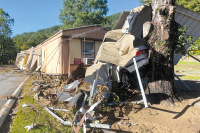Western Carolina responds to increased regulations regarding sexual assault
 By Katie Reeder • SMN Intern
By Katie Reeder • SMN Intern
With evolving regulations and a complicated system of reporting, there is no end in sight for the work university officials are doing to put a stop to sexual violence on campus.
“There is no start, and there is no finish. It’s continual,” said Ernie Hudson, chief of police at Western Carolina University.
Just this year, the chancellor’s office created a new position – chief compliance officer – in part to help ensure the university is meeting the requirements of Title IX – which prohibits sex-based discrimination in educational programs that receive federal funding.
Regulations
Title IX is just one of the many laws and regulations governing how universities respond to sexual violence. Under the Clery Act, higher-education institutions receiving federal funding must issue an annual security report detailing the types of crimes occurring on and near campus, whom the crime was reported to and when it happened.
Related Items
Although the Clery Act is four pages long, the Department of Education’s interpretation of how it should be implemented is more than 300 pages and includes what Hudson estimated to be 118 obligations of the school.
At the beginning of the 2014-15 school year, WCU created a position for someone to oversee compliance with the Clery Act. The position was created at the recommendation of a report on campus security issued by the University of North Carolina. The report included 36 recommendations for the institutions in the UNC system.
Tom Shanahan, general counsel for the UNC system, said this report was one the system conducts every few years to monitor campus security and safety. He also noted the increased regulatory activity around laws such as Title IX and the Clery Act in recent years and said certain recommendations were based on helping institutions ensure they were keeping up with those regulations.
Other regulations come straight from the U.S. Department of Education. In 2011, the department’s Office for Civil Rights issued a 19-page Dear Colleague Letter to colleges and universities to provide guidance and clarify the roles of these institutions in handling reports of sexual violence.
In addition to specifically mandated requirements, WCU has also taken cues from settlements involving how other colleges have handled sexual assault, said Mary Ann Lochner, WCU’s general counsel.
Though many of the cases the OCR deals with involve specific colleges and cases, the outcomes give guiding principles that are applicable to how all institutions handle sexual assault.
In May of 2014, the Department of Education released the names of the institutions with open Title IX investigations related to sexual violence. An updated list from the OCR shows there are 130 sexual violence cases under investigation at 117 institutions as of June 10.
“All of that goes into our policy,” Lochner said.
She said it can be difficult to reconcile the school’s responsibilities under the different laws, as those laws are coming from different agencies and offices — and from people who may not necessarily be in communication with each other.
Wes Chancey was hired this year as chief compliance officer. The decision to create the position came from the chancellor and Board of Trustees to help the university navigate the maze of higher education laws and regulations.
Chancey noted the recognition happening nationwide in higher education that campuses need some sort of centralized oversight to help ensure they are keeping within the lines of the rules and regulations that reach far beyond sexual assault and campus safety.
“We didn’t go down the compliance road because of Title IX or sexual assault,” Lochner said. “We went down the compliance road to be proactive and address the regulatory burdens in higher education. Higher education has got to be the most regulated industry in the country.”
“Honestly, I don’t know how anybody keeps up if they don’t have a centralized compliance function,” she said. “It’s getting harder and harder and harder.”
Still, Chancey’s focus now is Title IX and the multitude of other laws governing sexual assault.
“There’s been a lot of attention on this issue in the media – with that the new regulations, and it’s an area of law that’s developing,” he said. “So it’s naturally going to require the attention of a compliance officer.”
‘Separate ways of distributing justice’
Much of the confusion surrounding how campuses should handle reports of sexual violence comes from the fact that there are two avenues campus officials must pursue, Lochner said. The university is required to investigate the allegation to see if the accused party violated the student code while campus police investigate the allegation as a criminal activity.
“It’s two separate ways of distributing justice,” Chancey said.
The results of each process have different motivations, Lochner said. The university is primarily an educational institution while the police have an obligation to find out if a crime was committed and whether or not the perpetrator of the crime can be determined, Hudson said.
“I’m trying to put people in jail and hold them accountable to the legal system,” he said. “The university is trying to hold people accountable to the university system.”
Part of WCU’s policy is that police present every case to the district attorney. Hudson said this decision came about three years ago after noticing a perception throughout the country that campus police were not objective in handling reports of sexual assault. He said they then decided it would be a best practice to have a pair of outside eyes look at all cases.
“That way there’s no misconception that we have let some bias scare off our investigation,” Hudson said.
Both the university and legal systems are working simultaneously – often a difficult process for victims, as it requires them to retell their stories multiple times.
“It does breed lots of negativity,” said Shea Browning, WCU’s Title IX coordinator.
The university has taken steps to try to be sensitive to the victim’s needs. Lochner said there is a certified victim advocate who explains the process to victims so they can better anticipate what is coming next.
“We are sensitive to re-victimization,” Lochner said. “… We want to minimize trauma.”
Regardless of whether or not a victim chooses to press criminal charges, Browning said he must investigate as far as he can before hitting a dead end. This mandate also stands regardless of whether or not a victim wants to contribute to the investigation. The victim may choose not to do anything besides report the allegations, but Browning still must investigate whatever evidence is there. He said it is about being diligent with the available evidence.
“The bare minimum is as far as you can get with the information you have,” he said.
The Numbers
According to a 2015 poll by the Washington Post and the Kaiser Family Foundation, 20 percent of women and 5 percent of men reported they had experienced sexual assault. The poll surveyed 1,053 men and women between the ages of 17 and 26 who had attended a four-year college anytime since 2011.
A compilation of forcible sex offenses on campus by the Washington Post, indicates that WCU had 0.42 offenses reported for every 1,000 students in 2012. The University of North Carolina system school with the lowest ratio was UNC-Greensboro, which received no reports in 2012. The highest ratio belonged to UNC-Chapel Hill, which received 0.72 reports for every 1,000 students.
WCU’s 2014 Annual Fire Safety and Security Report shows three cases of rape in 2011, five in 2012 and four in 2013. The report operates on the calendar year rather than the academic year, and Hudson said the report with 2014 statistics will be available in October.
Hudson said the numbers have remained steady over the years, but university officials expect them to increase as students are encouraged to report their cases.
“(An increase) means education is working,” Browning said.
Challenges
Although the UNC Campus Security Initiative covered more than issues of sexual assault, some of its priority recommendations were in regard to cases of sexual violence. Shanahan said campuses were in agreement about the urgency of such issues and that there has been no resistance to implementing these recommendations. However, he said a general challenge they are encountering is finding the necessary funding for new positions and programs.
“There was widespread agreement that these were very good steps to take,” he said. “You want to have the most qualified people handling sexual assault cases… In order to do that, you’ve got to pay them the market rate, but that requires money.”
Bill Studenc with the office of communications said WCU has prioritized funding that would help them meet these requirements.
“At this point, all federal regulatory mandates and UNC policy changes have come without any additional funding for implementation, which means that the individual institutions have had to absorb these costs,” he said in an email.
Shanahan said the UNC Board of Governors recently approved a student fee of $30 that will provide some resources for campuses to use in meeting these requirements.
Prevention
Chancey said meeting educational requirements is one of the most challenging pieces of the laws and regulations. He said a big part of this is simply making sure employees know what they are required to do should someone report allegations of sexual violence to them.
Students and faculty are also required to complete training that helps them understand how they can help prevent sexual violence and respond to victims. Employees are required to report any allegations they are informed of.
Students must complete online training. If they fail to do so, they cannot register for classes.
WCU also sponsors the Red Zone – a joint initiative by departments across the university. The “red zone” refers to the early part of the year in student’s first and second years of college when they are at a higher risk for unwanted sexual experiences.
The program seeks to raise awareness and encourage students to speak up when they see any such behavior happening. Students, staff and faculty can also take a pledge to learn more about sexual violence and be an advocate for those who have experienced it.
“One of these is too much,” Chancey said. “That’s why we focus on it as much as we do.”
Beginning the conversation about sexual assault
“It’s not what everyone wants to talk about, but the conversations need to happen because that’s where preventing sexual assault begins,” said WCU student Adam Hampton.
Hampton transferred and finished his first year at WCU this spring. He served as the Red Zone committee chair for student government and emphasized the importance of starting campus conversations about assault – even if it makes people uncomfortable.
“It’s something that people know goes on,” he said. “It’s more of a taboo that people don’t want to talk about openly because it’s such a personal subject.”
Hampton said one of his goals with Red Zone this year was to enhance community relationships “because it’s a community issue.” He emphasized the need to bring the topic of sexual assault to the front of the minds of everyone on campus instead of treating it as an issue that shouldn’t be talked about.
He achieved part of this goal through the “It’s On Us” campaign, which originally came from the White House Task Force to Protect Students from Sexual Assault. The idea behind the campaign is that the responsibility of preventing sexual assault falls on everyone in the community and that it’s not just a problem for the victims.
“It really is on the school to have a stance on it and be supportive for victims and let people know they can speak,” he said.
Still, Hampton said there seems to be a breakdown between awareness and action. He estimated that 75 to 85 percent of the campus knows about Red Zone while the entire student body is required to complete online training about how to prevent sexual assault.
“I think there is a little bit of a mismatch between those students that are aware of it and those students who would act on it,” Hampton said. “People slide through, and they think it might not actually be happening.”
There seems to be a difference between awareness that sexual assault is a real issue and thinking about in the moments when it could happen. Hampton said in party settings, people may not be consciously aware of the possibility, and events can slip under the radar.
“By the time it’s happened, it’s too late,” he said.
That’s why Red Zone seeks to make people actively aware and equip them so that they do know how to respond if they see dangerous situations unfolding. Hampton noted the difficulty of stepping into these situations and said one of the program’s components is working with students on how to confront peers who may be engaging in unacceptable behavior.
He’s hopeful that by having these conversations and keeping this issue at the forefront of people’s minds, that they can combat sexual violence on campus.
“If we as a community really instill those habits in people, then I think it can dramatically reduce the incidents of sexual assault,” he said.
Terms to know
A host of laws and regulations govern how colleges and universities handle reports of sexual assault.
Title IX — As part of the Education Amendments of 1972, Title IX prohibits sex-based discrimination in federally funded education programs or activities, so it applies to K-12 schools as well as colleges and universities. Institutions are required to investigate all allegations of sexual assault and must make sure the act does not create a hostile environment or keep the victim from participating in or benefitting from educational activities and programs.
Source:www2.ed.gov/about/offices/list/ocr/docs/qa-201404-title-ix.pdf
Clery Act — Named after Jeanne Clery, a student who was raped and murdered in her dorm, the law took effect in 1990. It requires colleges and universities receiving federal funding to issue annual campus security reports detailing information about crimes that happened on or near campus.
Source: www.cleryact.info/clery-act.html
Campus Sexual Violence Elimination Act — The Campus SaVE Act is a 2013 amendment to the Clery Act that broadened the scope of what institutions must report in regard to interpersonal violence. Besides sexual assault, they must also report domestic violence, dating violence and stalking. The act also requires institutions to implement prevention and awareness programs about sexual violence, gives guidance for writing policies on disciplinary proceedings and victims’ rights.
Source: www.cleryact.info/campus-save-act.html
Violence Against Women Act —The law was originally passed in 1994, but President Obama signed an updated version of the bill in 2013. Although it reaches beyond college campuses, the law requires colleges and universities to provide information about domestic violence, dating violence, sexual assault and stalking. This includes reporting the number of crimes as well as publishing policies educating students and staff about resources for victims.
Source: www.whitehouse.gov/sites/default/files/docs/vawa_improvements_1_pager.pdf
Office for Civil Rights — The OCR of the U.S. Department of Education is the division that enforces civil rights laws pertaining to discrimination in educational settings. Students wishing to lodge a complaint against their college or university about its handling of sexual assault would contact the OCR.
Dear Colleague Letter — In 2011, the OCR issued a 19-page letter to institutions to provide guidance and clarify the roles of these institutions in handling reports of sexual violence. It has issued several versions of these letters — in matters besides sexual violence — which serve as reminders to institutions about how they should be implementing various regulations. The most recent letter came on April 24, reminding institutions that they are required to have a Title IX coordinator and detailing the functions of that position.
Source: www2.ed.gov/about/offices/list/ocr/letters/colleague-201104.html









